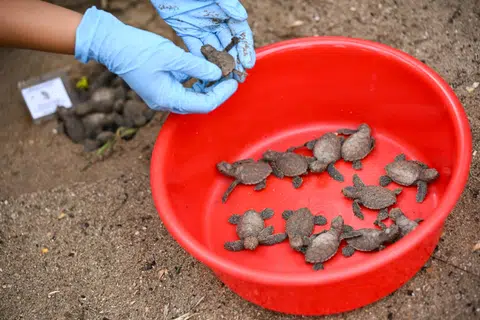Endangered sea turtle nests logged in Singapore highest since 2020
There are promising signs for the critically endangered hawksbill turtle.
The sands of Singapore have yielded promising signs for the critically endangered hawksbill turtle in 2025, as the number of nests uncovered has hit a five-year high, The Straits Times has learnt.
With nearly two months still left in the yearly nesting season, 18 nests have already been found, said Dr Karenne Tun, National Parks Board's (NParks) group director of the National Biodiversity Centre.
This is up from an average of 11 nests recorded annually from 2021 to 2024.
No trend has been discernible so far from the rise in numbers, according to NParks.
Hawksbill turtles, named for their hawk-like beaks, are mainly found in tropical seas. They keep coral reefs healthy through their appetite for sponges, affording time for corals to grow slowly.
Yet, the hawksbill faces a host of man-made threats, including the loss of nesting beaches, reclamation and other land uses, sea pollution and the illegal wildlife trade, where their mottled shells are highly prized.
Every year from May to October, the hawksbill - one of Singapore's two sea turtle species - crawls ashore to lay dozens of eggs on beaches at hot spots such as East Coast Park and Changi.
In 2018, a turtle hatchery was set up at Small Sister's Island to shelter nests vulnerable to disturbance and damage from foot traffic and boost the hatchlings' chances of living.
An estimated one in 1,000 sea turtle hatchlings survives until adulthood.

Dr Tun said: "Turtle nests, when encountered, are monitored to track hatching success rates and the factors that affect them.
"This allows NParks to introduce interventions where possible at each stage of the turtle life cycle to increase the chances of survival."
Meanwhile, Singapore's other turtle species - the green turtle - has not been recorded laying its eggs here. This is unlike nesting activity in neighbouring Malaysia, where the endangered species is far more common than the hawksbill.
Based on NParks' beach patrols that began in 2017, nesting turtles spotted in Singapore have all been hawksbills, said Mr Collin Tong, deputy director of the National Biodiversity Centre's coastal and marine branch.
"We are still trying to understand why that is the case," he said. "It is a good thing, but nobody knows why."
Some light has already been shed on the movements of local sea turtles, thanks to the coastal and marine branch's efforts to affix flipper tags and satellite trackers on arriving females, which are also measured to track their health.
To date, satellite data has shown that two nesting female turtles with trackers had originated from the Riau Islands in Indonesia.
Another two flipper-tagged mother turtles have also been found to return regularly to nest.
But much remains unknown, with research under way to better understand turtles that arrive here, their nesting behaviour and the impact of the warming world on their future.
Members of the public can help with sea turtle monitoring efforts by joining NParks' Biodiversity Beach Patrol through its website.
Those who encounter a nesting turtle on the beach should keep their distance and avoid shining lights or talking loudly, as these gestures can cause the mother to leave without laying her eggs.
The public should keep clear of tracks left by the turtles as researchers use the tracks to identify the species of turtle and to locate nests. The public should also contact the NParks helpline on 1800-471-7300 to report their sighting.
Ang Qing for The Straits Times